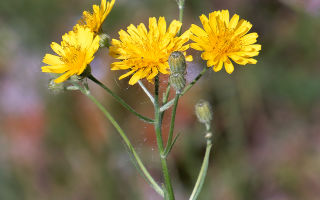Content
The healing properties of roofing skerda are used for digestive ailments, problems with blood vessels and for skin lesions. To use the plant with benefit, you need to study its features.
What it looks like and where it grows
Skerda (Crepis) is an annual or biennial plant from the Astrov family with a bare or pubescent stem. Possesses lanceolate whole leaves, on the lower surface of which there are noticeable pressed hairs. From June to October, it brings yellow reed buds, collected in baskets and larger corymbose or carpal inflorescences - up to five pieces per stem. From July to late autumn, it bears fruit with dark brown achenes with a silvery crest and spines in the upper part.

Skerda is widespread in North Asia, Europe and North America, and is also found in Africa. You can see grass on the sides of roads and on wastelands, on light forest edges, on dry meadows and in weedy places.
Chemical composition
The beneficial properties of skerda are due to its chemical composition. The leaves, stems and flowers of the plant contain:
- vitamin C;
- flavonoids;
- cellulose;
- fats and proteins;
- magnesium and silicon;
- proteins;
- calcium and phosphorus;
- organic acids;
- essential oils and antioxidants;
- tannins.
The rich composition makes the roofing and Siberian skerda a medicinal plant with strong antiseptic and strengthening properties.
Healing properties of roofing skerda, Siberian
The most popular in traditional medicine is the roofing rake, it is most widespread. Plant-based medicinal products have many valuable properties, namely:
- have a general strengthening effect and increase immunity;
- have a beneficial effect on the nervous system and normalize sleep;
- serve as prevention of atherosclerosis and strengthen blood vessels;
- help with bronchitis, pneumonia and tuberculosis;
- soothe the stomach for gastritis;
- promote healing of wounds and cuts;
- stop bleeding;
- have a laxative effect for constipation;
- reduce fever with a cold;
- cleanse the skin of boils, abscesses and carbuncles;
- improve kidney function and eliminate edema.
The herb can be used as an antiemetic. When applied externally, infusions and decoctions of roofing scherda promote the resorption of hematomas and soothe pain with bruises. In compresses and lotions, remedies improve the condition of joint ailments.
In addition to the roofing skerda, the Siberian variety is popular. It is less widespread, but has the same healing properties. It is used for hypertension and diseases of the respiratory system, for neuroses and insomnia, for bleeding. Siberian Skerda has an antibacterial effect and helps prevent inflammation in wounds and ulcers.
Preparation and application methods
Healing roofing skerda can be used externally and internally. Healthy drinks are prepared on the basis of the plant, and the leaves are applied to damage to accelerate regeneration.
Infusion
An aqueous infusion of medicinal roofing scurda helps with gastric disorders, weakened blood vessels and colds. They do it like this:
- dry grass is crushed in the volume of a large spoon;
- pour raw materials into a thermos and pour a glass of boiling water;
- close the vessel with a lid and insist for two hours;
- filter from plant sediment.
You need to take the remedy in accordance with specific recipes, usually 30-50 ml up to four times a day.
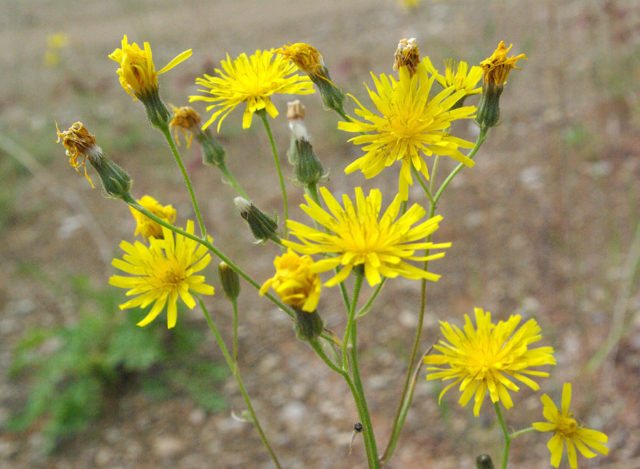
Leaf gruel
For wounds, burns, skin inflammations and furunculosis, fresh leaves of the roofing skerda are beneficial. It is very simple to process them:
- plant plates are washed with cool water to remove dirt and dust;
- in a blender or manually using a mortar, grind to a state of gruel.
The resulting green mass is applied in a dense layer to the damaged area of the skin and covered with a bandage on top for 30-40 minutes.
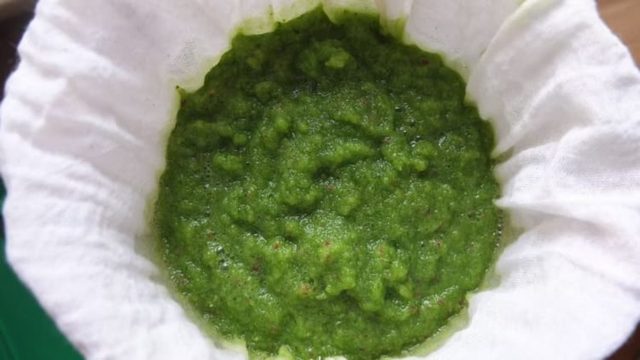
The use of Siberian skerda, roofing
Traditional medicine uses the useful roofing or Siberian skerda for several diseases. The plant is used to cleanse blood vessels and for problems with the stomach, as well as sluggish digestion.
Infusion for abscesses and carbuncles
Roofing skerda has an antibacterial effect, helps to relieve inflammation and resolve abscesses. For carbuncles, abscesses and boils on the skin, prepare the following infusion:
- measure out a large spoonful of dry grass and grind it to a powder state;
- pour 250 ml of hot water into a thermos or kettle;
- tightly close the container and put it in a dark place to infuse for two hours.
When ready, the product is filtered from the remnants of the leaves and poured into a clean glass vessel. In the infusion, it is necessary to moisten gauze or bandage and apply compresses to the abscesses several times a day.
With atherosclerosis
Roofing cloth improves blood circulation, cleanses blood vessels and strengthens their walls. As the prevention of atherosclerosis and for the treatment of the disease, the following drink is used:
- 15 g of dry grass is crushed with a mortar to maximum homogeneity;
- raw materials are poured with 500 ml of fresh boiling water;
- cover the container with a lid and wrap it with a towel;
- leave at room temperature for an hour to infuse.
After the expiration of the period, the healing agent must be filtered. It is taken three times a day, a large spoonful, it is best to drink the drug on an empty stomach shortly before meals.
With gastritis
Roofing cloth has a soothing effect on irritation of the mucous membranes of the stomach and esophagus. You can use the herb for gastritis with high acidity and peptic ulcer disease. A good action brings such a remedy:
- dry grass is crushed in the amount of a large spoon;
- 200 ml of hot water is poured into a glass container;
- removed to a warm, but darkened place for 3-4 hours;
- filter the drink through a gauze filter.
It is necessary to take the remedy from the roofing skerda 1/3 cup three times a day. The drug is drunk on an empty stomach shortly before meals, in which case the absorption of food will be of better quality.
For constipation
Fresh juice of roofing skerda has laxative properties. It can be used for constipation to enhance intestinal peristalsis and speed up digestion.Prepare the drug as follows:
- several fresh sheets of roofing skerda are washed in cold water from dust and soil particles;
- grind to the state of gruel with a blender or grind with a mortar;
- the resulting raw material is wrapped in folded gauze and the pure vegetable juice is squeezed into a glass container by hand;
- add a large spoonful of apple cider vinegar and 5 g of natural honey;
- mix until smooth.
It is necessary to take such a remedy on an empty stomach, preferably in the morning.
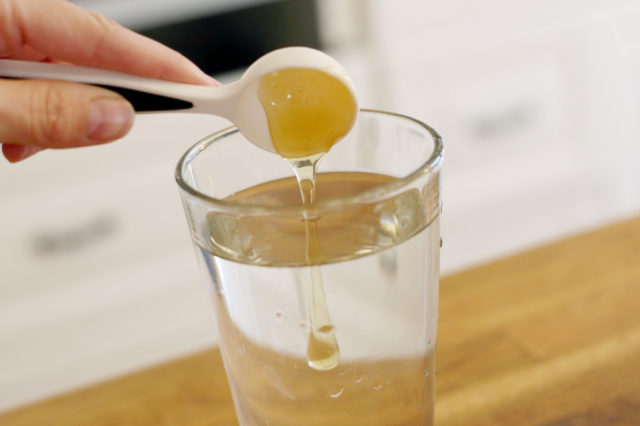
Contraindications
The useful properties of roofing skerda are not the same for everyone. In some cases, it is necessary to refuse to take a medicinal plant. In particular, skerda can harm the body:
- with individual intolerance to herbs;
- during pregnancy and during breastfeeding;
- with exacerbation of pancreatitis;
- with a tendency to diarrhea.
Products based on roofing skerda are not offered to children under 12 years of age. In babies, the plant is highly likely to cause an allergic reaction.
Collection and procurement
Traditional medicine uses the aerial parts of the roofing skerda, its leaves, stems and flowers to treat diseases. It is necessary to collect raw materials during the decorative period of the plant, in June and July, when the greens contain the maximum amount of nutrients. The harvesting is carried out on a dry and warm day. It is best to go for the medicinal plant in the morning, after the dew has dried, but before noon.
The stems and leaves are cut with a sharp knife at some distance from the ground. Since the roots of the herb are not used for medicinal purposes, the whole plant is usually not dug up. Upon returning home, the raw materials are washed in running cool water, and then laid out in an even thin layer under a canopy. You can also dry it indoors, choose a warm, but well-ventilated room.
During processing, the leaves and stems should not be exposed to sunlight. It is necessary to store roofing racks in fabric bags or paper bags in a dark place.
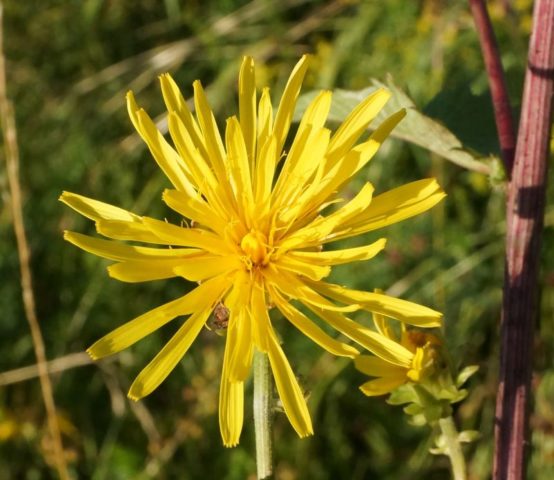
Conclusion
The medicinal properties of roofing skerda are beneficial for gastric disorders, furunculosis, skin lesions and other diseases. Healing infusions and remedies for external use are prepared from dry and fresh raw materials. When using skerda, it is important to observe the dosage so as not to damage the body.

